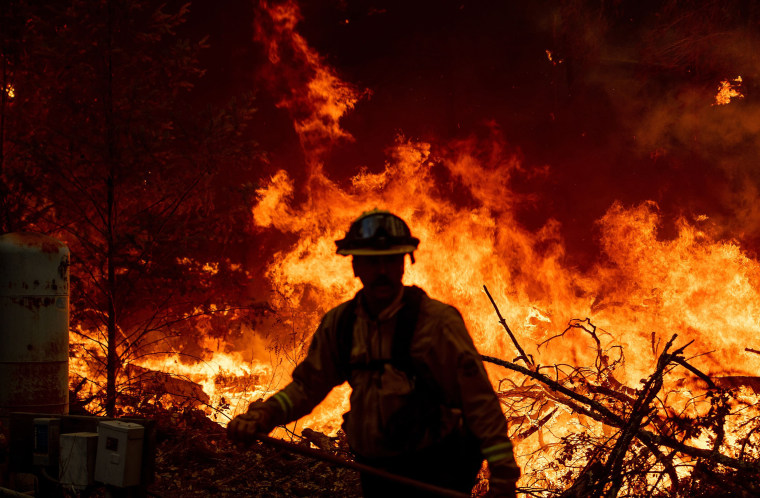ALAMEDA, Calif. — Mandatory evacuations were underway in Northern California on Sunday after a fast-moving wildfire ignited amid what weather forecasters called "extreme" fire conditions.
The Glass Fire, which erupted Sunday morning, was burning in the hills between the cities of Calistoga and St. Helena, in the well-known Napa Valley wine region, according to the California Department of Forestry and Fire protection. The department said the fire had grown to 1,500 acres with no containment.
A hospital in St. Helena, Adventist Health, suspended operations and moved all of its patients Sunday morning. In a statement, the hospital described the move as a precaution and said that patients were being transferred to other facilities while their relatives are notified.
Mandatory evacuations were issued for the communities of Deer Park and Angwin on Sunday, according to the Napa County Office of Emergency Services, which ordered more evacuations in the region on Sunday afternoon.
Aerial video captured by NBC Bay Area showed firefighting air craft drop retardant on flames rising from the hills below, while the Napa County Sheriff's Office published dashcam video showing a deputy plowing through the blaze to help with evacuations.
"Never wait til the last second to evacuate," the sheriff's office said.
The region has been hit hard this year, with one of the largest blazes in California history — the LNU Lightning fire — having scorched more than 363,000 acres. Three years ago, the Tubbs Fire devastated the area, killing 22 people and destroying thousands of buildings.
A couple of hours north, in Shasta County, mandatory evacuations were also ordered after the Zogg Fire ignited on Sunday afternoon. The fire was 400 acres, according to CalFire. The Shasta County Sheriff’s Office issued the evacuations in an area southwest of Redding, a city of roughly 92,000.
Forecasters attributed the the heat to a strong high-pressure system parked over the West Coast, said meteorologist Kristen Stewart of the National Weather Service office in Oxnard, California.
"The high pressure will keep the heat on for the week," she said.
Higher temperatures were expected to develop in Southern California on Monday along with offshore winds that could last through at least Thursday, she said. Temperatures are likely to reach the triple digits in inland valleys, she said.
A fire weather watch was in effect Monday for Los Angeles and Ventura counties.
The California Department of Forestry and Fire Protection said much of Northern California was under a red-flag fire warning of critical fire conditions for Sunday and Monday.
Pacific Gas & Electric—the utility whose equipment was blamed for the state's deadliest fire—announced Saturday that it would turn off electricity for 97,000 customers in phases as a precaution starting Sunday morning.
It was only two weeks ago that the largest wildfire in state history grew into a 870,200-acre behemoth on federal land north of Sacramento. The blaze, which started Aug. 16, was still burning and only 43 percent contained Saturday, according to Cal Fire.
"Firefighters are getting a break, but not much," said Cal Fire spokesperson Christine McMorrow. "We are getting a handle on the current fires, even some of those that have been burning since August."
The agency said 8,000 wildfires have burned more than 3.6 million acres since the beginning of the year. Since mid-August, there have been 26 fire-related fatalities, it said.
McMorrow said state firefighters were nonetheless ready should the weather whip up flames that are usually sparked by humans.
"We’re positioning resources and evaluating the weather day by day, hour by hour to make sure our troops are ready to go," she said.
Tim Stelloh reported from Alameda. Dennis Romero reported from Los Angeles.

